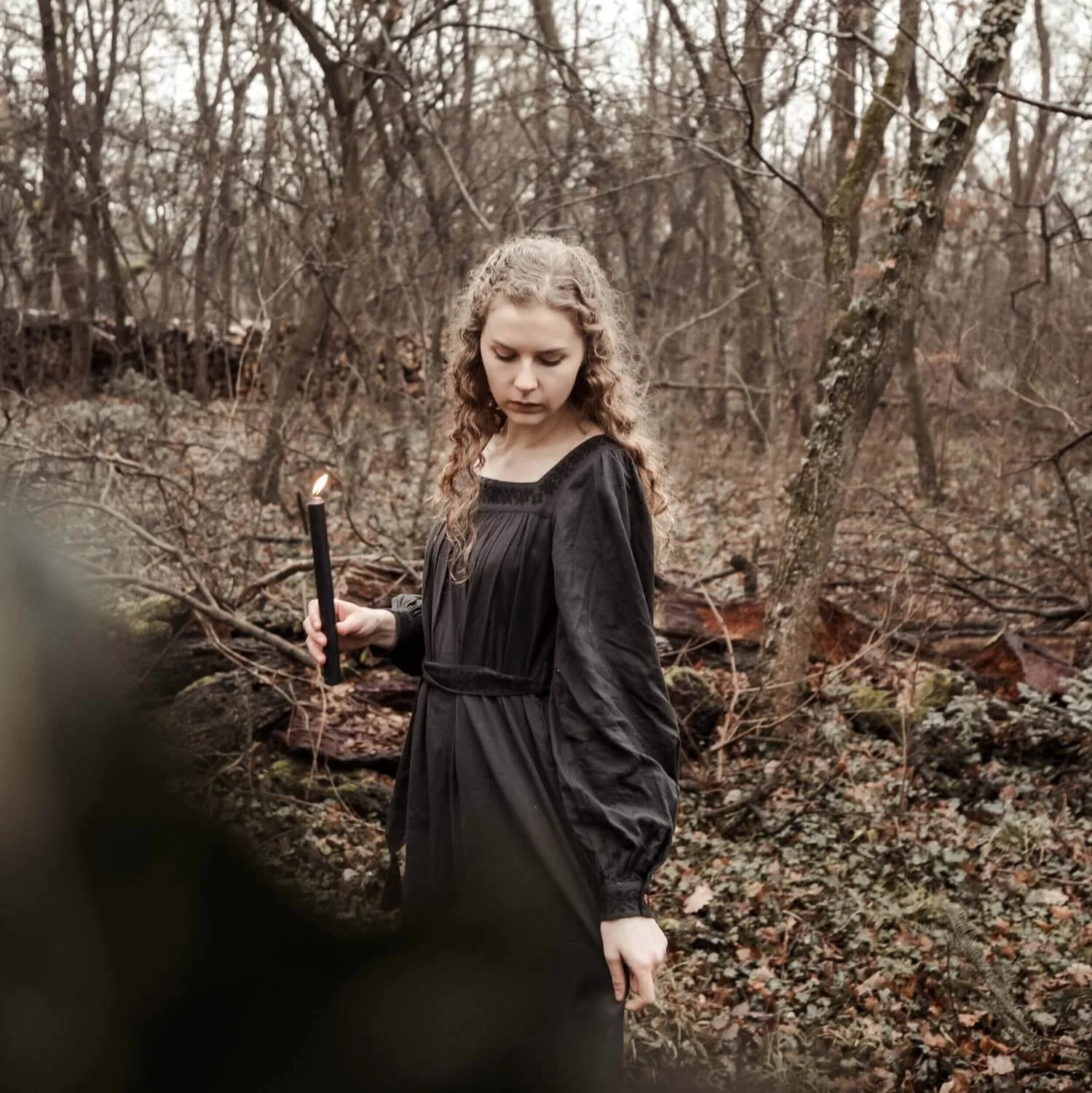How the Goddess Brigid Was Worshipped
The Celtic goddess Brigid has been worshipped in many different ways since Pre-Christian times. She was worshipped as the mistress of the sacred hearth, the healer of the waters, the bringer of sacred wisdom, forming a bridge between the human world and the Otherworld.
Like most goddesses, Brigid can be found throughout the Irish landscape -- masked by thousands of years of traditions and rituals. Brigid, the goddess, druidess, and saint, has been invoked to heal and impart wisdom to those who call upon her. Although Brigid is a mysterious goddess, her footprint can't be fully erased.
The druidess oak cult of the goddess Brigid
“Of all the Irish saints, Brigid of Cell-dara has been by far the most popular and has enjoyed the most widespread cult.”
In Kildare, an ancient chapel once stood, dedicated to the Celtic goddess Brigid, and then Saint Brigid. This was the cult of Brigid; where pagan women once gathered to worship the goddess in an effort to understand the esoteric truths she kept.
Brigid was especially important because she was seen as the gateway between the esoteric world and the human realm. A poem called Hail Brigid emphasizes her importance to the community at the time.
“Oh Brigit whose land I behold, on which each one in turn has moved about, thy fame has outshone the fame of the king—thou art over them all.”
Brigid and her connection to Kildare sheds even more light on her function as a goddess. Saint Brigid has always been associated with Kildare, or Cell-dara in Old Irish meaning “wood of the oaks.” According to the legend, her monastery was said to have been built on “The Church of the Oak'' that lay there before it. The folklore says that the church and monastery were built on a former shrine to the goddess Brigid — but what if this shrine was the oak trees themselves?
It’s likely that Brigid’s church and monastery were originally built in a sacred Celtic oak grove given this description. Oaks give an important clue to who the Celtic goddess Brigid really was, since to the ancient Irish, oaks were an important sacred tree closely associated with the druids.
Looking at the archaeology, there are records of Brigid’s first church being built on the site under an oak tree. The original building was built with wattles, a common building material from the Neolithic era onwards, and was directly under a large oak tree. This gives credit to the legend preserved in folklore and also strengthens Brigid’s own claim as a Celtic Goddess of esoteric wisdom.
The site is also positioned on a hilltop, a common feature in ancient deity worship. What’s more, records show that the church itself was built in wood. All over, oaks and the Celtic goddess Brigid go hand in hand.
How to invoke the goddess Brigid
“She is provider of plenty, giver of life and is also identified with nurturing, fertility and fire. All wells are sacred to Brighid for they are the doorway to the Underworld and the womb of our Mother, the source of all life. ”
The ancient Celts used to invoke Brigid for an array of functions. Healing was one of Brigid's primary functions in the Pre-Christian world and so, the ancestors used to invoke her to ask her for healing or to show gratitude.
One of the key places Brigid was invoked was near natural springs and wells. Since ancient times, people would go to springs and wells in the hope of being healed of their illnesses.
The most renowned well associated with Brigid is called Saint Brigid’s Holy Well in Kildare. It’s a simple stone well-fed with pure fresh mineral water with trees overhanging it. Ancient people would invoke Brigid by tieing a piece of cloth to the tree, called a "clootie" in Scotland, as a token offering for the healing water. This tradition is mirrored at nearly all other spring sites and has persisted since ancient times.
The practice even happens in Japan, where objects called yorishiro are left for the spirits or “kami” to attract them. According to Japanese tradition, the yorishiro give the kami physical space to occupy, attracting them to occupy the site.
So in a way, the pieces of cloth tied to a tree become the house where Brigid can occupy. The more clooties hung on a tree, the more likely it is that Brigid is actually there in the space with the people.
How to honor the goddess Brigid
“A perpetual flame burned in Kildare in pre-Christian times and was kept alight by Brigid and her nuns, possibly up to the sixteenth century.”
Brigid is closely associated with both fire, the hearth, and esoteric knowledge. Her fire associations stretch back to her pagan fire temple at Kildare, where druidesses or later nuns guarded her eternal flame.
Brigid's fire temple is probably the most interesting discovery associated with her. The fire temple was found on the same site as the monastery.
The temple was thought to be small and inside its walls, an eternal flame burned tended by nineteen priestesses called The Daughters of the Flame. In ancient times, eternal flames were found in many different cultures and were used to represent the ever-present nature of a deity. As long as the flame was lit, the spirit would continue to be present with the people.
The Daughters of the Flame were said to be priestesses or Bandrui in Irish meaning “woman druid.” The Roman accounts of this priestess cult were identified strongly with the Vestel Virgins of Rome, but I think we cannot assume that these women were also virgins, since Celtic society was less concerned with a woman’s virginity.
Bandrui in ancient Ireland were responsible for communing with the divine and imparting wisdom to the people in the form of lawmaking, medicine, philosophy, astrology, and other applications that were useful to society.
Since flames symbolize knowledge, then these Daughters of the Flame were probably responsible for imparting the wisdom of Brigid to those that came to seek it. Another interesting note is that the Fire Temple itself was surrounded by a ring of hedge and brushwood to “keep men out” indicating it was a sacred space for women. Any man that entered was said to have been punished.
Fire in mythology is always closely associated with illumination or enlightenment. In the Welsh druidic tradition, esoteric knowledge is called “Awen” and it describes how a poet or bard can know abstract concepts about the universe through devotion to the spirit world.
Looking to other cultures can also provide more possible insight into the function of the temple. In Chinese culture, eternal flames are representative of ancestor worship and remembrance. It could be that the Celts wanted to keep the flame alive to remember their ancestors, which in the mythology is cited as the Tuatha De Danann, which included Brigid as the daughter of the Dagda; the establishers of their civilization.
It's also interesting to note that the goddess Brigid was worshipped with bonfires at the beginning of February on Imbolc. The fires were thought to hasten the coming of spring, with themes of rebirth, fertility, and illumination.
In this way, Brigid's association with fire, women, and enlightenment makes sense. As a deity, women would worship her and tend to the eternal flame in order to find enlightenment. As a flame casts out darkness, so too does Brigid cast out the darkness of the mind.
Does Brigid protect the hearth?
For the average home, there are records that the Celtic goddess Brigid was invoked and worshipped by the hearth as a protectress of the home. This is because she was a fire deity, associated with the flame and women.
In local folk customs, Brigid is actually heavily associated with fire. In one Scottish ritual, the women of the house would level out the ashes and wait until morning to check to see if she “walked” across the ashes leaving her markings.
Part of this ritual could be leaving a straw bed out at night to welcome her. This is much the same tradition as those found in ancestor worship or the practice of inviting benevolent spirits into the home.
In Irish folk customs, fires would be raked out at night to preserve the glowing embers. This ritual was said to invoke Brigid by saying a special blessing over the fire so that she would protect the house until dawn.
In a ritual for fertility and motherhood, Ancient Celtic women would walk over smoldering embers and ash, allowing the smoke to waft into their vulva for blessings. Brigid's strong association with women and childbirth, especially for protection and fertility, shows through in this ancient tradition.
History, archaeology, and customs
Unlike other Celtic deities, there is so much evidence for the goddess Brigid. The historical accounts reveal Roman documentation of her primeval worship, the archeology reveals the structures and sacred places her attendants would invoke her at, and the folk customs surrounding her mythology all tie in together to reveal fascinating insights.
She was a goddess worshipped for her healing and protective abilities. As an aspect of the primordial Mother Goddess, Brigid is a goddess that helped people. Like her Christianized stories, we can assume in ancient times that she was invoked to heal the sick, help the poor, and bring clarity where darkness and confusion once were.
My favorite aspect of hers is her motto that her monastic order adopted: strong and gentle. She embodies both the strong warrior aspect and the gentle mother aspect. A mysterious figure both a goddess and a saint, Brigid has shown generations of people that healing and wisdom can be your strength.







Is Branwen a Celtic goddess? Or is she an exalted chieftain that has become legendary over time?